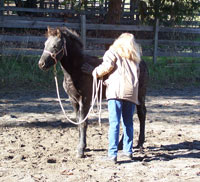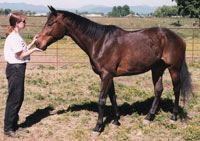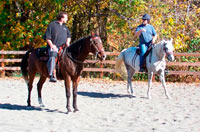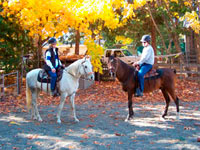Horse Training:
Owner Training
Here we come to an important point...
 While it is completely possible for me to do any and all of the training listed above with no involvement from the owner, it is far more effective if the owner/rider learns the “Hands-on” methods for themselves. Even the best-trained horse can revert back to one degree or another if the training is not reinforced consistently.
While it is completely possible for me to do any and all of the training listed above with no involvement from the owner, it is far more effective if the owner/rider learns the “Hands-on” methods for themselves. Even the best-trained horse can revert back to one degree or another if the training is not reinforced consistently.
I charge the same whether I am training only the horse or if I am working with both the horse and owner at the same time. While progress for the horse might be a bit faster if I am doing all the work, the progress made will ‘stick’ better and last longer if the owner learns how to reinforce the training themselves.
 The clock starts when I arrive and stops when I pack up to leave. So if the owner has the horse ready to begin training when I arrive, then the full-time can be dedicated to training.
The clock starts when I arrive and stops when I pack up to leave. So if the owner has the horse ready to begin training when I arrive, then the full-time can be dedicated to training.
The best bang for the buck is for the owner to be there, with the horse ready to go and stay through the whole session doing as much of the training and riding as possible, while I instruct.
Rider Training
 Of course, I can also offer instruction on being a better, more centered, and balanced rider during the 'in saddle' part of the training.
Of course, I can also offer instruction on being a better, more centered, and balanced rider during the 'in saddle' part of the training.
If you are a beginning rider or first-time horse owner, this instruction begins like the horse training... on the ground where I can help you learn the skills required to become the complete equestrian all horse owners and riders should be.
 My favorite method of instruction is to ride one of my horses right next to you as you learn, so I can demonstrate what I am instructing you to do.
My favorite method of instruction is to ride one of my horses right next to you as you learn, so I can demonstrate what I am instructing you to do.
If you don't yet have your own horse but wish to learn what you should know before purchasing one, I can help with this too. Your instruction can begin with one of my horses, and when you are ready, I can help you make your choice of the right horse for your riding goals.
Fees
Horses that are brought in for full-time training will run $775/month, including quality hay and board. All horses in full-time training will be worked for a minimum of 5 hours per week, with progress tracked on my blog so the owner can keep track of when their horse gets its training and what is being accomplished.
Horses hauled in for training will run $60/hour with a free half an hour added to the first visit where I will evaluate the horse and owner to see where things stand in both their training.
On-site training, where I come to you, also costs $60/hour with one half hour free to start, but I must also charge 35 cents per mile to cover travel time, gas, and vehicle wear.
Rider instruction runs $60, but I cut the price to $50/hr per rider for two riders and $40/hr per for three or more. So bring a friend and save some money. ;>
